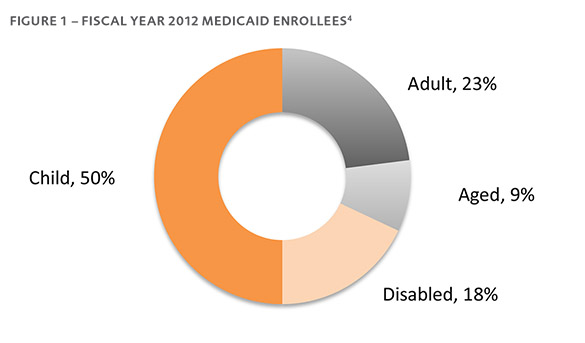This paper provides an overview of the intent of the Medicaid program and its budgetary implications. In 1965, when Medicaid was created under Title XIX of the Social Security Act to provide health insurance for low-income individuals, the program was considered an afterthought to Medicare. Today, however, more Americans receive coverage from Medicaid than any other health insurance program, including Medicare. Today Medicaid costs nearly $500 billion annually, funded by taxpayer dollars at the state and federal levels. This paper explains the budgetary implications of Medicaid for federal and state budgets and how these obligations will grow under the Patient Protection and Affordable Care Act.
Often called an afterthought to the Medicare program, Medicaid was signed into law under Title XIX of the Social Security Act. Unlike Medicare, which was created to provide health care coverage to those over the age of 65, Medicaid’s intent was the provision of care for individuals of any age who were financially limited. In 1966, Medicaid provided health insurance to 10 million beneficiaries. Currently with approximately 57 million people enrolled, Medicaid has evolved into the largest health insurance provider in the United States.
This policy brief will provide an overview of the Medicaid system, its budget implications at the state and federal levels, and the implications of the Patient Protection and Affordable Care Act (ACA) for states’ Medicaid programs.
What is Medicaid?
Medicaid is a government health insurance program providing coverage to individuals who are limited in their ability to pay for medical care. The program is run by the states using federal cost sharing dollars. Though state participation in Medicaid is voluntary, all 50 states and the District of Columbia participate. Each state, using federal matching funds, establishes and administers its own Medicaid program. As long as a state follows federal guidelines, it has the flexibility to determine the type and scope of services provided. Additionally, each state has the option of charging enrollees’ premiums and establishing out-of-pocket spending requirements such as copayments, coinsurance, and deductibles.
Although Medicaid eligibility varies dramatically from state to state, in order to qualify for federal funding each state must provide coverage to limited income families with children as well as individuals who are aged, blind, or disabled (see the percentage breakdown in figure 1 on the next page).
Though the income threshold varies by state, an individual or family applying for Medicaid cannot exceed a certain income threshold, which is calculated in relation to a percentage of the Federal Poverty Level (FPL). Today, the FPL ranges from $11,490 for a family of one to $39,630 for a family of eight. For example, consider a pregnant woman comprising a family of one and fitting categorically into one of Medicaid’s mandatory eligibility groups. In 2013, the median (across 50 states and the District of Columbia) Medicaid threshold for this individual was 185 percent of the FPL. Therefore, she would be eligible for Medicaid if she earned less than $21,257.
It is important to note that states may offer a greater number and additional types of services offered that go above and beyond what is mandated by the Department of Health and Human Services (HHS). Through Section 1115 of the Social Security Act, the federal government has encouraged states to tailor the Medicaid program to their unique political and economic environments. Building upon Section 1115 of the Social Security Act, the Health Insurance Flexibility and Accountability (HIFA) demonstration initiative gives states enhanced “waiver flexibility to streamline benefits packages, create public-private partnerships, and increase cost-sharing for optional and expansion populations covered under Medicaid.” Contingent on approval by the HHS Secretary, leaders are empowered to develop a unique program that meets their states needs.


